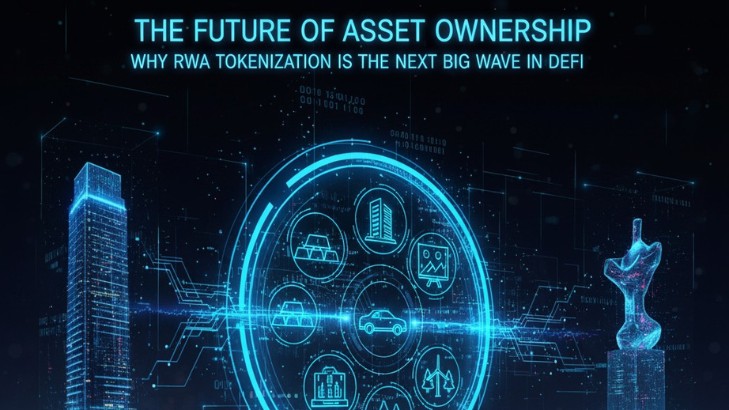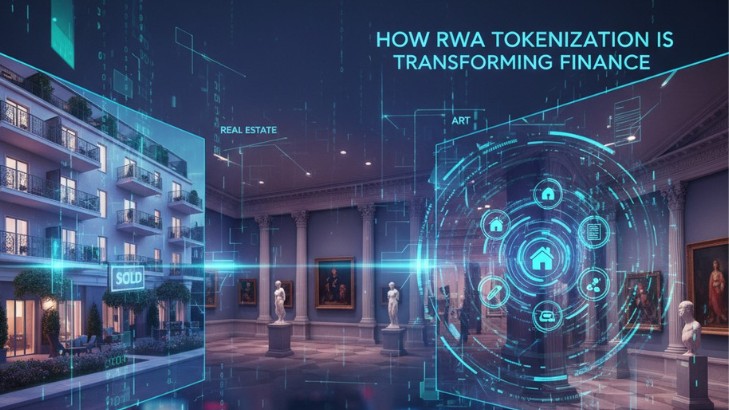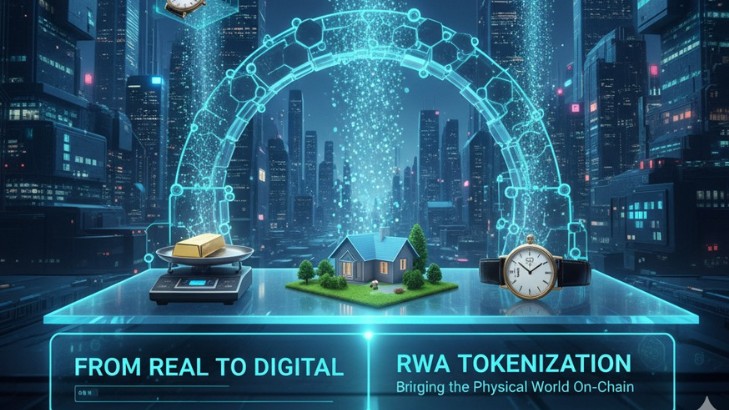5 Predictions for the Future of Securities Tokenization in 2024
January 8, 2024



The financial ecosystem is on the precipice of a monumental transformation, propelled by the advent of securities tokenization. In this era of rapid technological evolution, blockchain technology is emerging as a disruptive force, challenging traditional notions of how financial assets are issued, traded, and accessed. As we stand on the cusp of 2024, the potential ramifications of securities tokenization extend far beyond mere digitization.
In-Depth Overview
Before navigating the intricacies of the predictions, a comprehensive understanding of securities tokenization is paramount. This transformative process involves the conversion of conventional financial instruments – think stocks, bonds, and the like – into digital tokens residing on a blockchain. The driving impetus behind this paradigm shift is multifaceted. Firstly, securities tokenization promises to enhance liquidity by enabling fractional ownership and facilitating the seamless transfer of assets. Secondly, it aims to mitigate operational inefficiencies by automating traditionally cumbersome processes, ultimately leading to cost reductions.Lastly, and perhaps most significantly, securities tokenization seeks to democratize access to financial markets, opening the doors to a more diverse and global investor base.
The underlying principle is simple yet revolutionary: assets that were once confined to the realm of traditional finance are now being reimagined in a digital format, affording them newfound flexibility, accessibility, and efficiency. Blockchain, with its decentralized and immutable nature, serves as the technological bedrock for this financial metamorphosis. It introduces transparency, security, and trust into an arena that has historically been encumbered by intermediaries and opacity.
As we embark on this exploration, the intricate dance between traditional finance and emergent blockchain technologies is crucial to grasp. Securities tokenization is not merely a technical shift; it is a paradigmatic evolution that promises to reshape the very fabric of global finance.
Prediction 1: Mainstream Adoption of Tokenized Securities
The first prediction revolves around the mainstream adoption of tokenized securities. Platforms like Overstock's tZERO have paved the way for regulated marketplaces for digital securities. As regulatory frameworks mature and become more accommodating, traditional financial institutions are likely to embrace tokenization. This move not only streamlines processes and reduces costs but also opens the door to a broader investor base.
Example: Overstock's tZERO has positioned itself as a key player in the tokenization space, providing a transparent and regulated platform for trading digital securities.
As we look ahead to 2024, the financial landscape is expected to witness a surge in mainstream adoption, driven by the compelling benefits that tokenization offers to both issuers and investors. The move towards tokenized securities is not merely a technological trend but a strategic shift in how financial instruments is issued, traded, and accessed globally.
Prediction 2: Increased Regulatory Clarity
Regulatory uncertainties have been a significant impediment to the widespread adoption of tokenized securities. However, the second prediction anticipates a substantial improvement in regulatory clarity by 2024. Major jurisdictions worldwide are expected to establish comprehensive frameworks for the issuance and trading of tokenized assets.
Example: Switzerland, through its Financial Market Supervisory Authority (FINMA), has been at the forefront of offering clear guidelines for digital asset offerings.
This prediction is rooted in the recognition that regulatory clarity is pivotal for instilling confidence in market participants and fostering an environment conducive to innovation. As the regulatory landscape evolves, the financial industry is poised to witness a more harmonized and standardized approach towards securities tokenization.
Prediction 3: Integration with Decentralized Finance (DeFi)
The third prediction delves into the integration of securities tokenization with decentralized finance (DeFi) platforms. This convergence is expected to redefine traditional financial services, ushering in a new era of programmable financial instruments, automated compliance mechanisms, and decentralized trading protocols.
Example: The collaboration between MakerDAO and Centrifuge exemplifies the potential of merging DeFi with tokenized assets, enabling users to collateralize real-world assets on the blockchain.
As we approach 2024, the boundaries between traditional finance and DeFi are expected to blur. The synergy between securities tokenization and DeFi has the potential to unlock new possibilities, making financial services more accessible, transparent, and efficient for a broader audience.
Prediction 4: Enhanced Liquidity and Accessibility
The fourth prediction focuses on the anticipated improvement in liquidity and accessibility as more assets undergo tokenization by 2024. Tokenization has the potential to democratize access to traditional financial markets by removing entry barriers and fostering a more dynamic and inclusive financial ecosystem.
Example: Security token exchanges, including OpenFinance Network, play a pivotal role in facilitating secondary market trading of tokenized securities, contributing to enhanced liquidity.
In the coming years, the financial industry is poised to witness a significant shift in how assets are traded and accessed. The improved liquidity resulting from tokenization is expected to attract a diverse range of investors, from retail participants to institutional players, ushering in a new era of financial inclusion.
Prediction 5: Evolution of Tokenization Standards
The fifth prediction revolves around the evolution of industry standards for securities tokenization. Standardization is crucial for ensuring interoperability and facilitating the mass adoption of tokenized assets. By 2024, we predict the emergence of robust and widely accepted standards that will simplify the issuance, management, and trading of tokenized securities.
Example: The ERC-1400 standard for security tokens, proposed by a consortium including Polymath and ConsenSys, signifies a step towards creating a common framework for security tokenization.
As the tokenization ecosystem matures, the development and adoption of standards are expected to play a pivotal role in creating a more seamless and efficient market for digital securities. These standards will provide a common language for market participants, reducing friction and unlocking the full potential of tokenized assets.
The Role of Decentralization in Tokenization
Looking beyond 2024, the eighth prediction explores the increasing role of decentralization in the tokenization process. Decentralized systems and exchanges are expected to play a significant role in the trading of tokenized securities, contributing to a more inclusive and censorship-resistant financial ecosystem.
Tokenization in Traditional Industries
The ninth prediction anticipates the widespread adoption of tokenization in traditional industries such as real estate, art, and intellectual property. Platforms like Propy are leveraging blockchain for transparent and efficient property transactions,showcasing the potential for fractional ownership and increased liquidity in once illiquid markets.
Example: Propy is at the forefront of utilizing blockchain for transparent and efficient property transactions.
The Impact of Quantum Computing on Tokenization
As technology advances, so do potential challenges. The tenth prediction addresses the impact of quantum computing on tokenization. While quantum-resistant cryptographic techniques are under exploration, the industry must proactively prepare for potential vulnerabilities that quantum computing could introduce to existing tokenization infrastructures.
Example: IBM's Quantum Network is actively engaged in quantum computing research, exploring the implications for cryptography and data security.
Tokenization and Sustainable Finance
The eleventh prediction explores how tokenization can contribute to sustainable finance. The transparent and traceable nature of blockchain can be leveraged to ensure that tokenized assets align with sustainable and ethical standards. Platforms like Provenance are facilitating transparency in supply chains, contributing to sustainable and ethical practices.
Example: Provenance is leveraging blockchain for transparent and sustainable supply chains.
Challenges and Risks in Securities Tokenization
While the future of securities tokenization appears promising, the twelfth prediction acknowledges the challenges and risks associated with this transformative shift. Regulatory uncertainties, technological vulnerabilities, and the need for robust identity verification processes are among the challenges that industry participants must navigate to ensure the successful implementation of securities tokenization.
Conclusion
In conclusion, the landscape of securities tokenization in 2024 is poised for a revolutionary overhaul. The predictions outlined in this exploration paint a picture of a financial world that transcends traditional boundaries, driven by technological innovation and a quest for efficiency,accessibility, and inclusivity. From the mainstream adoption of tokenized securities and increased regulatory clarity to the integration with decentralized finance, enhanced liquidity, and the evolution of industry standards, the stage is set for a transformative journey.
As investors, industry stakeholders, and innovators navigate this uncharted terrain, the key lies in adaptability and a keen understanding of the dynamics at play. The road ahead promises challenges, but with them comes the potential for a financial landscape that is more resilient,transparent, and accessible than ever before. The seeds of change have been sown, and the fruits of securities tokenization are poised to redefine finance in ways that were once considered unimaginable.
References
The information presented in this blog post is sourced from reputable publications, official guidelines, and industry-leading platforms. Readers are encouraged to explore these references for in-depth insights into the evolving landscape of securities tokenization.




.avif)



